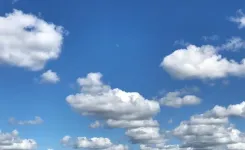Why are fish getting smaller as waters warm? It’s not their gills, finds study led by UMass Amherst
Biologists find no link between fish size and gill surface area—study suggests that models underlying some projections of future fisheries yields need to be reconsidered
2024-02-21
(Press-News.org) February 21, 2024
Why Are Fish Getting Smaller as Waters Warm? It’s Not Their Gills, Finds Study Led by UMass Amherst
Biologists find no link between fish size and gill surface area—study suggests that models underlying some projections of future fisheries yields need to be reconsidered
AMHERST, Mass. – A collaborative team of scientists led by the University of Massachusetts Amherst recently found that there is no physiological evidence supporting a leading theory— which involves the surface area of fish gills —as to why many fish species are “shrinking” as waters grow warmer due to climate change. Known as the Gill Oxygen Limitation (GOL) theory, it has been proposed as the universal mechanism explaining fish size and has been used in some predictions of future global fisheries yields. However, the researchers, representing the National Oceanic and Atmospheric Administration, U.S. Geological Survey, the University of California Davis as well as UMass Amherst, conducted a series of long-term experiments on brook trout and found that, though increased temperatures do lead to significantly decreased body size, gill surface area did not explain the change. The results of the study were recently published in the Journal of Experimental Biology.
“We know that global climate change is happening and our oceans and rivers are getting warmer,” says Joshua Lonthair, lecturer in biology at UMass Amherst and the paper’s lead author. “And we know that many animals—not just fish—are growing to smaller adult body sizes under warmer temperatures. We even have a name for this, the Temperature Size Rule. But despite decades of research, we still don’t understand why size decreases as temperature increases.”
In both marine and freshwater fish species, rising water temperatures have a critical effect on metabolism, reproduction and other life functions, but a critical factor that most of the models underlying fisheries management rely on is fish size. Commercial fisheries are often regulated by tonnage, and when fish shrink, it takes more of them to fill out a ton. Lower weight is also linked to reduced reproduction. Altogether, this means that managers need to adjust their models for our changing world.
But how?
A leading theory, GOL, holds that fish growth is limited by how much oxygen gills can pull from the water. As the water warms, the biochemical processes of the fish speed up and require more oxygen. The GOL contends that gills have limited surface area that constrains the amount of oxygen they can supply, and thus, fish cannot grow as large under warm water conditions. Therefore, fish are “shrinking” to fit the limited oxygen that their gills can supply.
The GOL theory underlies widely cited model projections of drastic reductions in future global fisheries yields, including some used by the International Union for Conservation of Nature—but it has never been directly tested.
“We noticed that prior studies on GOL rely on data repurposed from other, unrelated research projects that weren’t designed to specifically to test the theory,” says Lisa Komoroske, assistant professor in environmental conservation at UMass Amherst and the paper’s senior author. “We designed a series of long-term experiments which collectively are the first effort to empirically test GOL.”
Specifically, Lonthair, Komoroske and their colleagues wanted to see how the three key ingredients of GOL—growth, energetic demands and the surface area of fish gills—changed as water temperatures increased. To do this they turned to brook trout, which are ideal test subjects: scientists already know a great deal about the species, they are fast-growing, economically and ecologically important to the Northeastern U.S. and they are comparatively easy to work with.
Once they had their test subjects—small fry that initially weighed between one and two grams each—they were placed into tanks, some of which contained normal, 15º Celsius water, and some of which contained water warmed to 20º Celsius. The fish were weighed and measured at the start of the experiment, and then monthly thereafter. Their oxygen consumption was also measured at two weeks, three months and six months, which is a way of ascertaining metabolic rate. Finally, the researchers collected gill samples from the same fish to measure changes in their gill surface area.
Once they began analyzing their data, a few things became clear: the brook trout in the warmer tanks were smaller, as expected, and in line with the Temperature Size Rule. However, the gill surface area was more than enough to meet the fishes’ energetic demands, which means that their growth was not limited by the surface area of the gills, as GOL predicts.
Furthermore, the team found that while the warm-tank fishes’ metabolic rates did increase at the three-month mark, by six months their oxygen rate returned to normal, suggesting that the fish could adjust their physiology over time to account for the increased water temperatures.
“Oxygen use may still be an important limiting factor in fish size,” says Lonthair, “but, taken together, our findings show that GOL cannot predict what we’re seeing, and this has implications for predicting climate impacts on future fisheries and ecosystems.”
“Our work highlights the importance of interdisciplinarity,” adds Komoroske. “Fisheries and macroecology scientists tend to work on the population and species level, while the physiologists tend to work on the individual and cellular levels. But these are academic distinctions, not natural ones, and if we’re going to help fish survive warming waters, we need to work across biological scales and join the insights of all these fields.”
So what is the mechanism governing fish size and temperature? “We don’t know yet,” says Lonthair. “And it may not be a single mechanism—it may be a host of factors, including oxygen use. We need more interdisciplinary long-term studies so that we can understand how best to adjust to our warming world.”
A media kit with images is available in this Google Drive folder.
Contacts: Lisa Komoroske, lmkomoroske@umass.edu
Daegan Miller, drmiller@umass.edu
END
ELSE PRESS RELEASES FROM THIS DATE:
2024-02-21
New research published in the Journal of Orthopaedic Research suggests that the physical postures, breathing exercises, and mindfulness practices of yoga may benefit individuals with back pain.
In the study, 10 women with and 11 without chronic low back pain underwent an 8‐session yoga program over 4 weeks, with the first session conducted in a clinic and the rest delivered with a tele‐approach. Women with chronic low back pain experienced a significant decrease in pain intensity, as assessed through a 10-point visual analog scale (an average ...
2024-02-21
The American dream narrative posits that anyone who works hard can become successful in the US, whereas the systemic racism narrative argues that the US is a racist country where minorities are systemically held back.
A survey-based study in Analyses of Social Issues and Public Policy found that these narratives predict individuals’ support for the presidential candidacy of Donald Trump or Joe Biden, above and beyond more traditional political ideologies.
In a follow-up experiment in which participants were confronted with news clips of immigrant deaths at the border, white individuals decreased their ...
2024-02-21
Renewable energy production leads to reduced carbon dioxide emissions in countries that are members of the Organization for Economic Co-operation and Development (OECD) but increased emissions in emerging economies, according to the results of a study published in the Natural Resources Forum. A similar disparity was seen when considering the environmental impacts of innovation. (The OECD is an international organization that works to build better policies for better lives. Thirty-eight countries around the world are currently members.)
Regarding ...
2024-02-21
In a study published in Neurourology and Urodynamics, adults who spent 5 or more hours a day watching TV and/or videos were more likely to develop nocturia, or the need to urinate multiple times during the night.
The study drew from 2011–2016 data from the National Health and Nutrition Examination Survey. Among 13,294 US individuals aged 20 and older, 4,236 (31.86%) reported experiencing nocturia, while 9,058 (68.14%) did not. Participants with 5 or more hours of TV and/or video viewing time per day had a 48% higher risk of experiencing nocturia compared with those with less than 1 hour of daily TV and/or video viewing time.
“As ...
2024-02-21
New research indicates that some age-related changes in gene and protein expression in the skeletal muscles of older individuals may be affected more by physical inactivity and chronic inflammation than primary aging, or intrinsic maturational processes.
Physical inactivity and chronic inflammation are the most important drivers of secondary aging, or changes over time that are caused by extrinsic factors such as diseases or poor health practices.
In the Aging Cell study that included 15 young healthy people and 8 young and 37 older patients with knee or hip osteoarthritis (who suffered from long-term inactivity ...
2024-02-21
A new paper in Nicotine & Tobacco Research, published by Oxford University Press, finds that banning the sale of menthol cigarettes would likely lead to a meaningful reduction in smoking rates.
Menthol cigarettes are of particular public health concern because studies have found that the cooling effects of menthol mask the harshness of cigarettes, making it easier for young people to start smoking. Prior research has also found that menthol in cigarettes makes it easier for smokers to absorb nicotine, which results in ...
2024-02-21
When clouds meet clear skies, cloud droplets evaporate as they mix with dry air. A new study involving researchers from the University of Gothenburg has succeeded in capturing what happens in a model. Ultimately, this could lead to more accurate climate modeling in the future.
The clouds in the sky have a significant impact on our climate. Not only do they produce precipitation and provide shade from the sun, they also act as large reflectors that prevent the radiation of heat from the Earth – commonly known as the greenhouse effect.
“Although clouds have been studied for a long time, they are one of the biggest sources of uncertainty in climate models,” ...
2024-02-21
Trust, a cornerstone of human interaction, has a significant genetic component, with around 33% of the variation between individuals attributed to our genes, according to new Australian research using data from twins and a meta-analysis of previous studies on the heritability of trust.
Successful relationships, economic transactions and social cohesion are all a matter of trust. Without trust, businesses collapse, political parties fail, and conflicts erupt, whether on a personal or international scale, resulting in broken hearts and lives lost.
“Higher levels of trust are associated with a range of social and economic benefits, ...
2024-02-21
People who eat a healthy, plant-based diet that is high in vegetables, fruit, whole grains and nuts are less likely to suffer with obstructive sleep apnoea (OSA), according to a study published today (Wednesday) in ERJ Open Research [1]. However, people eating an unhealthy plant-based diet, high in refined carbohydrates, sugary drinks, high-sugar and high-salt foods, are at a higher risk of OSA.
People with OSA often snore loudly, their breathing starts and stops during the night, and they may wake up several times. Not only does this cause tiredness, but it can also increase the risk of high blood pressure, stroke, heart disease and type 2 diabetes.
The new study ...
2024-02-21
The expression "flawless from every angle" is commonly used to characterize a celebrity's appearance. This doesn't simply imply that they appear attractive from a specific viewpoint, but rather that their appeal remains consistent and appealing from various angles and perspectives. Recently, a research team from Pohang University of Science and Technology (POSTECH) has employed metasurface to fabricate angle-dependent holograms with multiple functions, capturing significant interest within ...
LAST 30 PRESS RELEASES:
[Press-News.org] Why are fish getting smaller as waters warm? It’s not their gills, finds study led by UMass Amherst
Biologists find no link between fish size and gill surface area—study suggests that models underlying some projections of future fisheries yields need to be reconsidered




